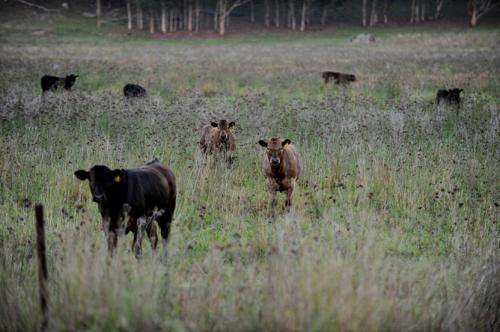Anthrax kills cows in NSW's north: Experts respond

At least 37 cows have died after an anthrax outbreak in Moree, northern NSW, it was reported today.
Here are some expert responses to the news, collected by the Australian Science Media Centre.
Dr David Beggs, lecturer in cattle in the Faculty of Veterinary Science at the University of Melbourne
The current outbreak does not ring alarm bells with me from a human health point of view – only about 40 animals have died on only two farms in three weeks, so far as I understand it. Anthrax is a worry because the spores last a long time (possibly hundreds of years) and it can infect people. That said, antibiotics are very effective, and we've had a vaccine since Louis Pasteur invented it in 1881!
Anthrax spreads by animals (or people) coming in contact with spores, which are mostly released by dead animals but can remain in the ground for years. It doesn't spread like an infectious disease between people and/or animals. Because of this, we can successfully contain the disease through a combination of carcass disposal, quarantine and vaccination. Australia has no anthrax to speak of at the moment and because of that, we call even a single case an "outbreak".
We have an excellent nationally agreed plan of action for when anthrax pops up (AUSVETPLAN) and if you want to know what the authorities will be doing about the latest outbreak, all you have to do is look up the plan – it's detailed and effective.
Professor Julian Rood, Professor of Microbiology in the Department of Microbiology at Monash University
Anthrax is an infectious disease of humans and animals caused by a bacterium. There are a couple of reasons why the anthrax bacterium is dangerous. The primary reason is that it makes a powerful toxin called anthrax toxin. The effects of this toxin are the primary cause of disease. Secondly, it also makes a very resistant form of the bacterium that is called a spore. The spore form is able to survive adverse environmental conditions – so it can survive in the soil for long periods of time up to decades. So, you can have an outbreak of disease, the spores can enter the soil and then many many years later the spores can infect another animal and make that animal sick. That is usually the major mechanism of spread in cattle, the animals pick up the spores from the soil.
Outbreaks are rare but not unusual, they occur from time to time, they are not occurring continually but every few years in various regions of NSW and Victoria you can get an outbreak of anthrax. So it's rare but not unusual.
What is the risk to humans from infected cattle? There is a risk of skin infection from handling hides or handling infected tissues or handling, for example, wool from infected sheep. In fact the skin form of the disease used to be called "wool sorters disease" probably a century ago.
So humans can pick up the disease from infected cattle by handling infected material. But there are various forms of the disease in humans. The most common form in humans from infected cattle is known as the cutaneous form of the disease – or the skin form of the disease. Importantly the disease does not spread from person to person. This is also quite different from the systemic form of the disease that was an issue during the 'anthrax in the mail' problems in the US some years ago. This inhalation form of anthrax is much more dangerous and quite different to the situation here.
Source: The Conversation
This story is published courtesy of The Conversation (under Creative Commons-Attribution/No derivatives).
















